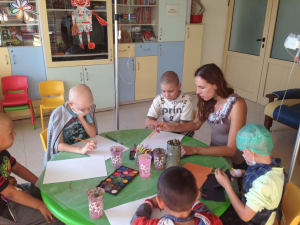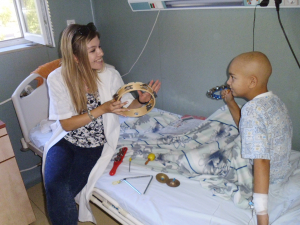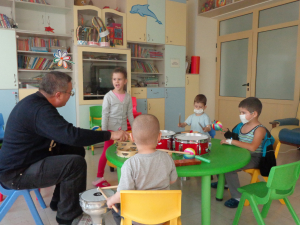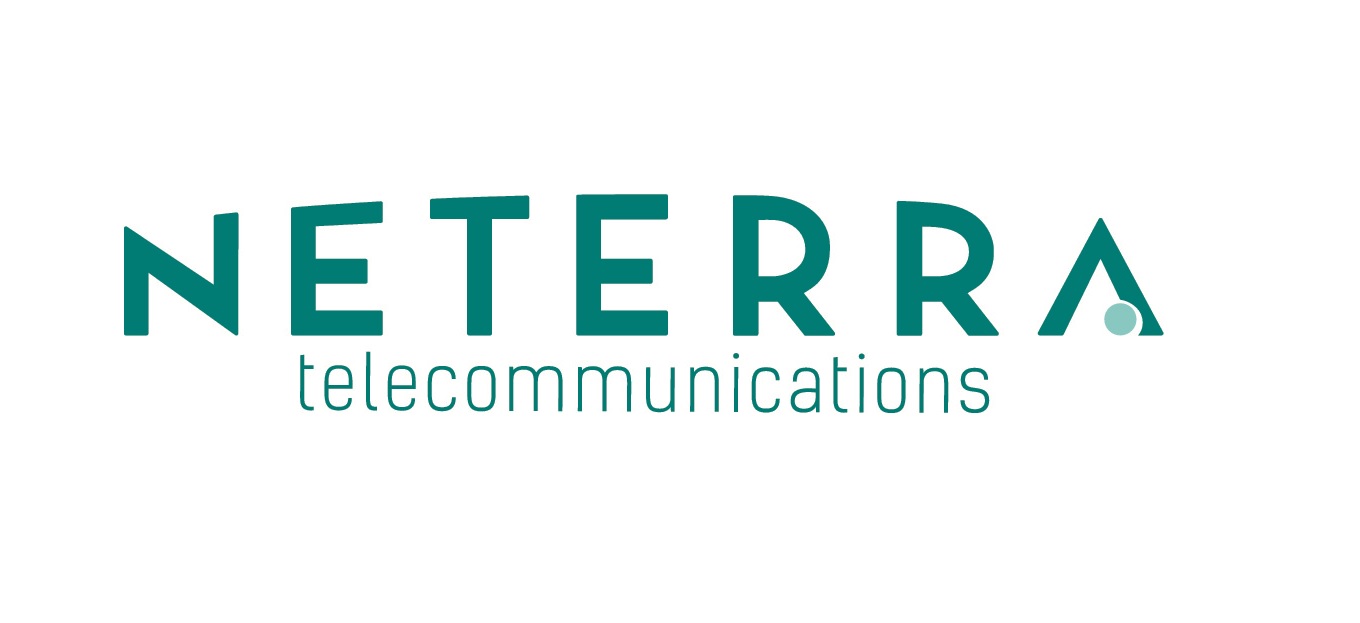Just because adults have more experience with language than children doesn’t necessarily mean they are any better at understanding their own emotions and telling others what they’re experiencing.
Often, in dealing with adult problems, it’s even harder to articulate what hurts and why.
Distress from pent-up emotions and complex experiences that need articulation is an especially common experience for people in caring professions.
Art therapy is a promising therapy for end-of-life caretakers, helping them feel competent, develop emotionally-focused coping skills, and increase emotional awareness – an essential skill to prevent burnout (Potash et al., 2015).
Caring professionals especially need the defense against burnout that art therapy can provide, but any adult is susceptible to burnout and could use the coping skills taught through art therapy.
Below are five activities for adults that can provide an opportunity to help them better understand themselves. Some of them are for use with clients addressing a specific area, and others are more generally therapeutic.
While these exercises might not be facilitated by a professional art therapist, many of them were developed and used by art therapists and can still make a difference for the individual seeking release.
1. Unmasked – Expressive Art Therapy Directive
This activity was created for people who suffer from eating disorders or who have body image problems. People who suffer from these afflictions often create masks to hide behind that can operate as distractions from other issues, keep others from seeing their suffering, or keep them from seeing their own dysfunction.
This activity involves creating masks that help explore the participants’ symbolic masks. Creating masks can be done individually or in a group setting.
The activity can help participants discover suppressed parts of themselves, uncover new coping strategies that aren’t food or body related, and confront a fear of what would happen if the body- and food-focused mask was removed (Art Therapy Blog, 2017).
Here’s how to carry out the activity.
You will need:
Depending on your resources and how confident you are, you could help participants to make plaster masks from scratch, or you could purchase some pre-made blank masks online or from a local arts and crafts store.
Keep in mind if making plaster masks from scratch, there is a drying time between layers of plaster, so this activity would need to be carried out throughout several sessions. If you are seeking to deliver a one-off workshop activity, the pre-made masks might work best. Other materials to use could include:
- Coloring pens
- Feathers, pipe cleaners, pieces of different fabric and materials
- Glitter and sequins
- Scissors and glue
Begin by:
- Explaining to participants the concept of masks and how each of us might have unconscious masks that we often hide behind. Encourage participants to reflect on their own experiences of this. When do they think they hide behind a mask? What triggers their hiding? What would that mask look like if it were real?
- Next, ask participants to engage in a mindful minute. Close their eyes and focus on their breathing. Allow thoughts of their mask to enter their mind but ask them to think about what their ‘best face’ mask might look like, the one they want people to see rather than the one they hide behind to cover up their food or body-related behaviors. What would that mask look like?
- Provide them with the pre-made masks (or begin to create them from scratch if pursuing that route) and all the materials. Encourage them to create their ‘best face’ mask.
- When their masks are complete, they could use them to further roleplay their ideas about themselves and issues represented by the different masks they wear.
2. The Lighthouse Activity
For those who feel lost, overwhelmed, or isolated, expressing those feelings and visualizing hope can be a therapeutic and beautiful way to identify needs, feel hope for the future, and realize where they are on a specific journey.
The activity involves imagining being lost at sea and visualizing the ideal lighthouse that would provide the right kind of guidance. This is a great activity for both children and adults, but an older group or individual might better appreciate the depth and symbolism of the project.
Here are the instructions.
You will need:
- Plain or colored paper
- Coloring pens and pencils
Begin by:
- Start with a basic guided meditation. Ask participants to sit comfortably, close their eyes, and turn their focus to their breathing. Allow a minute or two for participants to clear their minds and become settled.
- As participants continue to meditate and relax, explain that it is common for all of us at points in our life to feel lost, isolated, or overwhelmed. It can be a scary time, and we often think there is no way out, but there is usually always a light to help guide us back to safety.
- Next, start to tell participants a story. They have been out on a boat on a clear day, but as the day progressed, the weather has taken a turn for the worse. The sky has darkened, the sea is black and choppy. It is cold, and water is flowing into the boat. They have lost their way and are unsure of how they will find their way back again. But, in the distance, they see a light – it is a lighthouse showing them the way to safety. They must head towards the lighthouse.
- Bring participants out of their meditation and provide them with the materials. Instruct them to draw, color, or paint a lighthouse as a source of guidance. Encourage them to depict themselves in relation to the lighthouse somewhere in the image and to add words that represent sources of guidance in their life.
3. The Self-Care Box
Affirmation and inspiration are the keys to the self-care box. It can be comforting to have something small, tangible, and beautiful in times of trouble. This is a simple activity that can have impactful results at times of need.
The box can be used as a resource, and its ongoing creation can be therapeutic for the participant.
Here’s how to make a self-care box.
You will need:
You can ask participants to make their own box out of cardboard, or you can find small, plain, and inexpensive wooden boxes from many arts and crafts stores. Whichever you choose, you will also need:
- Coloring pens and pencils
- Glitter, sequins, pieces of materials like lace, etc
- Old magazines, newspapers or picture books
- Scissors and glue
Begin by:
- Asking participants to reflect on their ideas of self-care. What does it mean to them? What are some of the things, behaviors, people, or activities that help them feel good about themselves and that feel like self-care?
- Encourage them to think about the emotions, feelings, words, and images or colors that these ideas for self-care evoke within them.
- Next, provide them with the boxes and materials. Tell them that these self-care boxes will be used to store small trinkets, souvenirs, and quotes that align with their ideas of self-care.
- Participants can then decorate their boxes to best align with their ideas of self-care. Encourage them to decorate or line the box with positive affirmations. These can be self-generated, generated by group members, or found online. These can also be simply folded and put into the box to be read when needed.
- Use the box for items that provide comfort, like worry stones, pictures of friends or family, clips of quotes or poetry, pressed flowers, or treasured jewelry or mementos. They might even leave some movie vouchers or massage gift cards in the box that can be used when they feel drained and in need of self-care.
4. The Poem Collage
Self-criticism can make the act of creation difficult, and often that difficulty in finding the words to express your feelings is because you’re self-conscious of how inadequate the expressions can feel.
By creating a poem from a pool of words collected from sources like magazines, newspapers, and old books, you can create a un-self-conscious poem that molds pre-existing words to your feelings.
Here’s how to make a poem collage.
You will need:
- Old magazines, newspapers, picture books, and scrap paper
- Colored pens and pencils
- Scissors and glue
- Cardboard or thick paper for the base of the collage
- This activity can be carried out with a group or one-to-one
Begin by:
- Explain the concept of self-talk to participants, and how when we talk negatively to ourselves, it can significantly impact our mood, emotions, and feelings of growth and happiness.
- Encourage a discussion around how and when participants are self-critical of themselves and when they engage in self-talk. Ask them to reflect on whether their loved ones would say these things about them? What would their loved ones say about them instead?
- Provide participants with the materials and encourage them to create their own word/poem collage filled with positive affirmations and kind words they would like to attach more to themselves and how they think about their own person.
- Let participants be as freely creative as they want, including images and colors that also make them feel good.
- When they have finished, instruct them to take this home and place it somewhere they look every day. Encourage them to spend 3-5 minutes each morning or evening, taking in what they have created and build these positive words and images into their day.
- If a project like this is used in a group or therapy setting, practitioners could ask the participants about their word choices, chosen themes, or interpretations of the poems (Frank, 2014).
5. The Family Sculpture Activity
The Family Sculpture exercise is a popular art therapy activity that exists in many other therapy types, such as family therapy, though in a modified form. It is enlightening for clients to mold their family in a way that represents the members and the dynamics, and it helps them identify problems in relationships that otherwise might be ignored.
It is a great activity to use with adults, where family dynamics and relationships are more ingrained, to bring awareness to how these things impact our thought processes.
Here’s how to carry out the activity.
You will need:
- Simple modeling clay or plasticine
Begin by:
- Explain to participants that our families have a significant role in our lives. From an early age, the ways we engage with our families shape how we go on to engage as adults and within other relationships. It’s important to reflect on our family dynamics to understand how and why we might communicate in the ways we do, so we can better work to change the ways that might be negative.
- Provide participants with the clay or plasticine, and ask them to shape and mold members of their family. A useful way to direct this activity can be to encourage participants to create abstract shapes or use other objects to represent certain family members.
- Next, ask participants to position the family members in ways or scenarios that they feel best to reflect the family dynamics more generally.
- Participants can then be encouraged to discuss the shapes or objects they have chosen and why. Try to go deeper to uncover what these shapes represent. If used in a full therapy session, participants could also use the figures to conduct a roleplay, which can then be discussed with the therapist to uncover deeper thoughts and ideas about their family relationships (Malchiodi, 2010).
Helpful Art Therapy Activities for Anxiety
More than 18% of adults in the U.S. are affected by anxiety disorders each year, which is close to 40 million people (Facts & Statistics, 2017).
Anxiety is experienced differently by individuals and can range from low to severe. The range of symptoms experienced is also extensive, which means for many people, it often goes undiagnosed. Understanding how anxiety shows up in your life, what triggers an anxious response, and developing your positive coping strategies is crucial for living with anxiety.
One of the most enlightening parts of art therapy is the process of creation, which can be just as revealing as the final product. However, for people with anxiety, there may be an intense need to finish the creative process and to create a universally appealing subject matter.
For anxiety sufferers, self-discovery, and healthy coping mechanisms are essential, and art therapy techniques are among the healthiest ways to deal with some of the symptoms and experiences of living with anxiety.
Below are five art therapy activities, specifically designed to support individuals with anxiety therapy.
1. The Panic Book Activity
People with an anxious panic disorder can spiral into a panic, just thinking about the possibility of having a panic attack. Panic attacks can have many triggers, sometimes known, but often not.
The Panic Book activity encourages participants to create a book full of images that help them to feel calm, as a way to keep calm in times in during stressful situations and help refocus their mind onto something more positive.
Here’s how to carry out the activity.
You will need:
- Artist sketchbooks, notebooks or plain notebooks
- Coloring pens and pencils
- Magazines, newspapers, old picture books, etc
- Any other craft materials participants might use to create their book. For example, you could download some free words of affirmation images from the internet or ask them to bring a selection of photographs that are meaningful for them.
Begin by:
- Open the activity with a discussion about how the individuals feel about their panic attacks. Demonstrate empathy and let them know they are not alone in their experiences. Today’s activity will help them to create a resource to support them during panic times.
- Provide each participant with a blank sketchbook/notebook. Tell them this will become their Panic Book, and within it, they are going to create a reserve of images and words that help them to feel calm.
- Allow participants to use all the materials provided to begin creating their panic book. They can do this however they choose but if someone feels stuck, encourage them to perhaps start by creating a theme for different sections of their book such as the beach, favorite places, and people, or nature scenes.
- Participants do not need to fill the entire sketchbook in this one session. Advise them it is something they can come back to over time and add to as they find more words and images that evoke feelings of calm and comfort for them.
- Encourage them to keep this book close with them, so if they feel a moment of panic approaching, they can refer to it as a resource to help distract them and focus on the things that evoke calm emotions.
2. What Anxiety Looks Like Activity
Understanding and visualizing anxiety can be a pivotal first step in controlling and treating it.
Representing anxiety as an abstract concept, a human, or even a monster could help the artist develop strategies to recognize it when they feel it coming on and to deal with it appropriately. This activity allows participants to do just that.
Here’s how to do the activity.
You will need:
- Any decorative materials to help participants create their ‘anxiety’ could include:
- Paints and easels
- Coloring pens and pencils
- Collage materials
- Sculpting clay
- Miscellaneous materials such as fabrics and textures
- Scissors, paper, and glue
Begin by:
- Introduce the concept of the workshop activity by discussing anxiety more generally. Ask participants to reflect on the idea that anxiety is mostly an unseen thing, but what if we could see it? What would it look like?
- Ask participants to take a mindful minute to reflect on these questions. Ask them to close their eyes and focus on their breathing. Now, turn their thoughts to their anxiety. If they had to describe it, where would they begin? Does it have a body and a head and limbs, or is it more abstract? What shape does it take? Is it tall, short, skinny, fat? What color is it?
- Next, ask them to reflect on the personality of the anxiety. How does it talk, or is it silent? What does it care about? How does it express its cares?
- Once participants are comfortable, provide them with the materials, and ask them to recreate their anxiety. They can use any medium they feel comfortable with.
- For the next steps, when participants have completed their creation, discuss the appearance and personality of the anxiety, or journal about what they’ve discovered (Tartakovsky, 2015).
3. Creating Mindfulness Beads
Similar to a worry stone or fidget cube, mindfulness beads can be a simple, cheap coping mechanism that’s fun to create and easy to carry around.
Here’s how to make and use mindfulness beads.
You will need:
There are a few ways to create mindfulness beads, depending on who you complete the workshop with and your skill level:
- Purchase a mixture of beads from a dedicated bead or arts and crafts store
- Find some old jewelry at home or from a thrift store that you can take apart
- Use simple oven-bake modeling clay to make the beads
You will also need:
- Some strings or leather strands to add the beads to
Begin by:
- Explain the concept of mindfulness to participants, if they are unfamiliar with it, and talk them through a short introductory mindfulness exercise. Ask them to close their eyes, and focus on their breathing, feeling each breath as they slowly inhale and exhale.
- Then, explain the concept of mindfulness beads and that you will be creating them. Mindfulness beads can be used during times of anxiety as something to refocus their mind and create a distraction from anxious thoughts while they practice mindfulness.
- Provide participants with whichever option of creating their own beads you have chosen. Ask them to take a moment to think about the colors they find most enjoyable and what textures they might like to feel when trying to distract themselves.
- They can use the beads and string to create a keychain, a bracelet, or a necklace, whichever they feel would be most helpful for them.
- When finished, advise that when using the beads, they can simply reflect on the overall appearance and texture, or they can touch and focus on one bead at a time, assigning meaning and using each bead as a prompt for meditation.
4. Zentangle Drawing Activity
Drawing patterns that allow your brain to enter a peaceful flow state reduces anxiety and helps promote a feeling of peace, slowing down time, and allowing you to focus on the present moment.
Zentangle was created with the promise that anyone can do it, even if they don’t think they can draw well enough to create something beautiful. Drawing Zentangles creates a feeling of accomplishment and helps to pass the time in a thoughtful, healing way.
Here’s how to draw Zentangles.
You will need:
- Coloring pens and pencils
- Plain paper
Begin by:
- Instruct participants to take a moment to feel gratitude and express appreciation for the materials and the opportunity to create something beautiful. Remind them that the activity is not about artistic skill or who can draw better than anyone else. There are no wrong or right ways to complete the activity.
- Provide each participant with paper and their choice of pens/pencils. Ask them to draw four dots, one in each corner, so the page is no longer blank and intimidating.
- Next, instruct them to connect the dots by drawing a light border around the edges of the paper, creating a square.
- Within that square, they can draw a string – a line – or multiple strings, that divides the paper into different sections. They can do this any way they like, creating as many different shapes as they like.
- Now that they have a square filled with shapes, ask them to pick one shape and to begin filling it in with more defined shapes, strokes, dashes, lines, or dots, keeping within the pre-drawn border. Tell them to move around the page filling in each shape with its own unique set of shapes, lines, and pen strokes. They can be as creative as they like with this, rotating the paper to suit their free-flowing creativity.
- Advise participants this is their creative piece to shade in different ways, and use different colors if they would like to.
- Participants keep going until they have filled the entire page.
Translation, professional adaptation and re-posted from https://positivepsychology.com/















